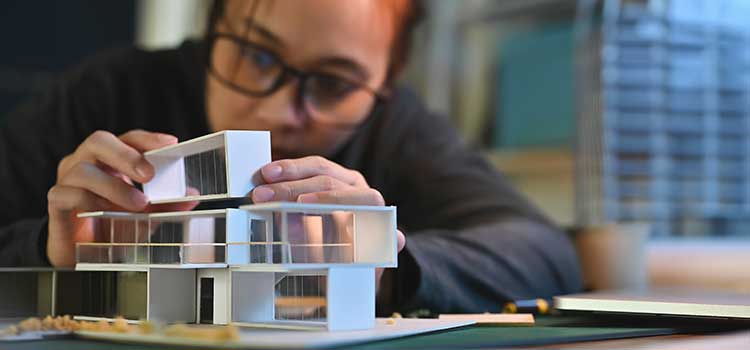Architect Workflow Enhancement for Quicker Project Delivery
Architect Workflow Enhancement for Quicker Project Delivery
Blog Article
Recognizing the Diverse Profession Paths Available for Aspiring Architect
As an ambitious Architect, you have a world of occupation paths waiting for you. Whether you're attracted to traditional design or the subtleties of sustainable layout, there's a specific niche that lines up with your rate of interests.
Conventional Design: Designing Structures and Structures
Standard architecture focuses on making buildings and frameworks that blend capability with visual appeal. Your styles can show social heritage, showcasing neighborhood practices while fulfilling modern-day demands.
You'll create skills in drafting, model-making, and website analysis, permitting you to envision and communicate your concepts efficiently. Involving with customers, you'll require to recognize their vision and convert it into practical styles.
In addition, constructing codes and sustainability practices are necessary in your job, ensuring your structures are risk-free and ecologically friendly. As you expand in your profession, you'll find chances in property, industrial, and even restoration projects, each offering distinct challenges. Embracing typical style leads the way for a fulfilling profession that admires the past while shaping the future.
Urban Preparation: Shaping Communities and Public Spaces
As an aspiring Architect, you can play a vital role as a metropolitan organizer, changing how areas engage and operate. By employing area engagement methods, you'll guarantee that homeowners have a voice in forming their environment. Plus, incorporating sustainable style principles will certainly help develop rooms that not just satisfy today's demands but additionally safeguard the future.
Duty of Urban Planners
While several may assume of architects as the sole dreamers behind structures, metropolitan planners play a necessary function in shaping the wider landscape of communities and public spaces. By collaborating with various stakeholders, you'll help make parks, transport systems, and property areas that promote social communication and access. Your proficiency in spatial design and area characteristics allows you to envision future development while protecting cultural heritage.
Area Interaction Techniques
Effective area interaction techniques are essential for metropolitan planners to assure that the voices of homeowners are heard and valued in the preparation procedure. To cultivate purposeful dialogue, you should focus on open online forums and workshops where community participants can express their concepts and worries. Use studies and social networks to get to a wider target market, guaranteeing varied perspectives are consisted of. Working together with neighborhood organizations can enhance trust fund and help with much deeper connections. It is very important to provide clear details regarding decision-making processes and proposed jobs, permitting locals to really feel informed and equipped. By proactively paying attention and incorporating feedback, you'll produce rooms that reflect the neighborhood's demands, eventually resulting in more effective and lasting city environments. Embrace transparency and constant discussion for lasting effect.
Lasting Style Concepts
When making metropolitan rooms, incorporating lasting design principles is vital for creating environments that thrive both environmentally and socially. You need to begin by concentrating on power effectiveness, utilizing materials that reduce waste and advertise recycling. Take into consideration incorporating eco-friendly spaces, like parks and gardens, to boost biodiversity and boost air high quality. Promoting walkability and public transport can reduce reliance on autos, cultivating a much healthier area.
Designing with water conservation in mind is additionally essential-- think of rain gardens and absorptive surface areas to manage stormwater. Including area participants during the preparation process guarantees that the rooms you create satisfy their demands and motivate social communication. By accepting these concepts, you'll contribute to vivid, sustainable city landscapes that benefit everybody.

Landscape Design: Producing Sustainable Outdoor Settings
As you explore landscape style, you'll find vital design concepts that create practical and gorgeous exterior rooms. Sustainable practices play a crucial function in making sure these settings prosper while reducing ecological effect. Plus, you'll discover a variety of occupation opportunities that enable you to make a real distinction in just how people connect with nature.
Style Concepts in Landscape
Comprehending layout principles in landscape design is important for developing sustainable outside atmospheres that balance with nature. You'll require to consider components like scale, percentage, and balance to guarantee your styles feel natural and inviting. Including native plants not just improves biodiversity yet also minimizes water usage, making your landscape durable. Think of the circulation of room and exactly how individuals interact with it; paths and seating areas need to invite exploration and leisure. Additionally, take notice of seasonal adjustments, making with materials that match the environments year-round (Architect). By focusing on sustainability and appearances, you can produce exterior spaces that enhance the neighborhood and promote well-being. Welcoming these principles will set a solid structure for your career in landscape design.
Lasting Practices Introduction
Lasting methods in landscape style not only concentrate on visual appeals yet also prioritize eco-friendly health and source preservation. You can develop spaces that advertise soil health, such as utilizing natural products and practicing permaculture concepts. Ultimately, these techniques assure your designs benefit both people and the atmosphere for years to come.
Profession Opportunities Exploration
With a strong structure in sustainable techniques, landscape style provides a variety of job paths that allow you to make a purposeful effect on the environment. Urban organizers typically collaborate with landscape engineers to develop environment-friendly rooms in metropolitan settings, improving city livability. If you're passionate about education, take into consideration becoming click over here a landscape style educator, motivating future generations.
Sustainable Style: Concentrating on Eco-Friendly Practices
As you explore your job in design, welcoming eco-friendly techniques can set you apart in an affordable field. Sustainable design focuses on developing buildings that lessen environmental effect while improving resident wellness. By integrating renewable materials, energy-efficient systems, and lasting building strategies, you'll add to a greener future.
Start by obtaining understanding of eco-friendly certifications like LEED or BREEAM, which can boost your qualifications. Consider just how natural light, air flow, and thermal efficiency can optimize style. Team up with designers and ecological specialists to introduce remedies that reduce waste and conserve resources.
Don't fail to remember the relevance of community involvement-- appealing regional stakeholders can inspire styles that balance with the atmosphere. As customers significantly focus on sustainability, your know-how in eco-friendly practices will not only attract projects however likewise satisfy your enthusiasm for accountable design. Accept this vital facet of the career, and see find more your job prosper.
Historical Conservation: Securing and Restoring Cultural Heritage
While you commence on your building trip, think about the necessary function of historic preservation in maintaining our social heritage. This area concentrates on the security and remediation of considerable buildings, sites, and frameworks that inform the stories of our past. By taking part in historical preservation, you'll help guard the building legacy that forms neighborhood identification.
As a historic preservation Architect, you'll analyze historic relevance and evaluate the problem of structures. You'll function very closely with historians and preservationists to guarantee genuine reconstruction methods are used. This occupation path allows you to blend creativity with research study, allowing you to create remedies that value original products and workmanship.
Your work not just contributes to sustainability by reusing existing structures however additionally fosters a sense of satisfaction within communities. Accepting this course will assist you come to be a guardian of history, protecting the tales and appearances that enrich our lives.
Inside Design: Enhancing Indoor Spaces
Historic conservation and indoor style both share a dedication to improving the built try this web-site setting, but they concentrate on various facets. While historical preservation emphasizes preserving a structure's historic and cultural value, indoor style zeroes in on maximizing interior areas for performance and visual appeals.
As a hopeful Architect, you'll find that interior style enables you to blend creativity with technical skills. You'll develop areas that not just look excellent yet additionally advertise convenience and performance. This area entails understanding how light, color, and materials interact within a space, affecting mood and functionality.
You'll deal with various projects, from residential homes to industrial offices, making sure that each environment satisfies the requirements of its passengers. By prioritizing user experience, you can change insides into functional and motivating rooms, making a substantial influence on exactly how people interact with their environments. Welcome the chance to enhance indoor settings and shape the method people live and work.
Industrial Style: Merging Functionality With Visual Appeals
Industrial layout plays an essential duty in producing products that flawlessly mix aesthetic appeals with functionality, ensuring that what you make use of everyday is not only aesthetically attractive but additionally functional. As a hopeful Architect, you could involve on your own in this area, focusing on making every little thing from furnishings to consumer electronic devices. Your work entails comprehending customer requirements, materials, and making procedures, enabling you to create ingenious remedies that enhance day-to-day experiences.
In industrial layout, you'll frequently team up with engineers, makers, and online marketers, guaranteeing that your layouts are not only stunning yet also possible. You'll learn to stabilize form and feature, focusing on usability without compromising style. By refining your abilities in laying out, 3D modeling, and prototyping, you'll be well-equipped to bring your ideas to life. This occupation course provides a vibrant setting where creativity satisfies functionality, making it a fulfilling selection for engineers curious about forming the items of tomorrow.
Frequently Asked Concerns
What Educational Qualifications Do I Required to End Up Being an Architect?
To become an engineer, you'll need a professional level in style, normally a Bachelor's or Master's. Furthermore, you'll have to complete a teaching fellowship and pass the Architect Registration Examination to exercise lawfully.
Exist Accreditation Needs for Different Architectural Job Paths?
Yes, there're accreditation needs for numerous architectural courses. Architect. You'll need to pass tests, full internships, and in some cases go after specialized training, relying on your chosen focus, like landscape style, metropolitan design, or historical preservation
What Software Program Skills Are Necessary for Architects Today?

How Can I Gain Practical Experience While Researching Design?
You can gain functional experience by interning at architectural companies, participating in layout competitions, offering for community tasks, or collaborating with schoolmates on real-world projects. These possibilities enhance your skills and build beneficial connections in the sector.
What Job Opportunities Exist Outdoors Traditional Design Firms?
You can discover various work possibilities outside conventional style firms, like metropolitan planning, interior layout, landscape design, building and construction management, property growth, or even functions in sustainability consulting. Each deals unique difficulties and benefits.
Whether you're attracted to traditional design or the subtleties of lasting layout, there's a niche that lines up with your passions.When designing urban rooms, including lasting layout principles is important for creating settings that grow both environmentally and socially.As you check out landscape style, you'll discover vital style principles that create beautiful and useful exterior spaces.Understanding style principles in landscape design is crucial for developing sustainable outdoor environments that harmonize with nature.In industrial layout, you'll commonly team up with designers, marketing professionals, and producers, ensuring that your layouts are not only stunning however also practical.
Report this page